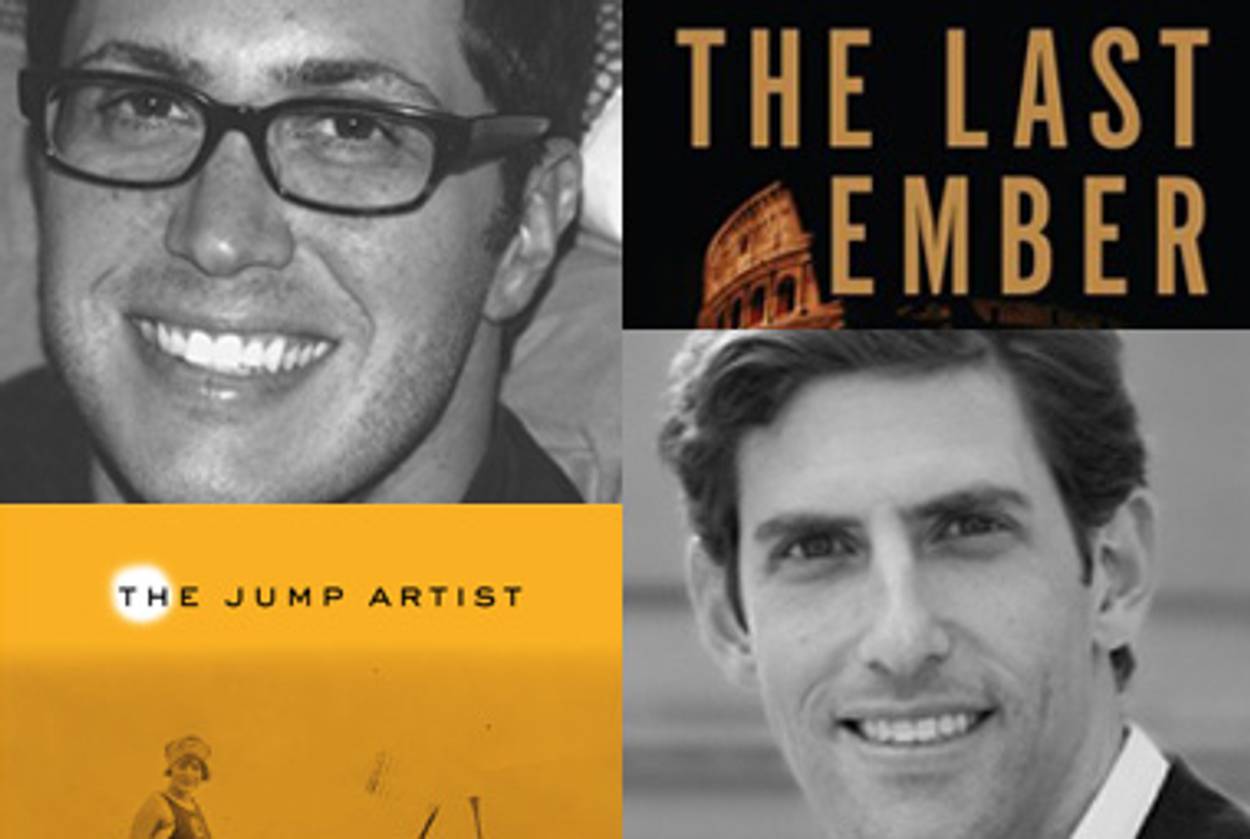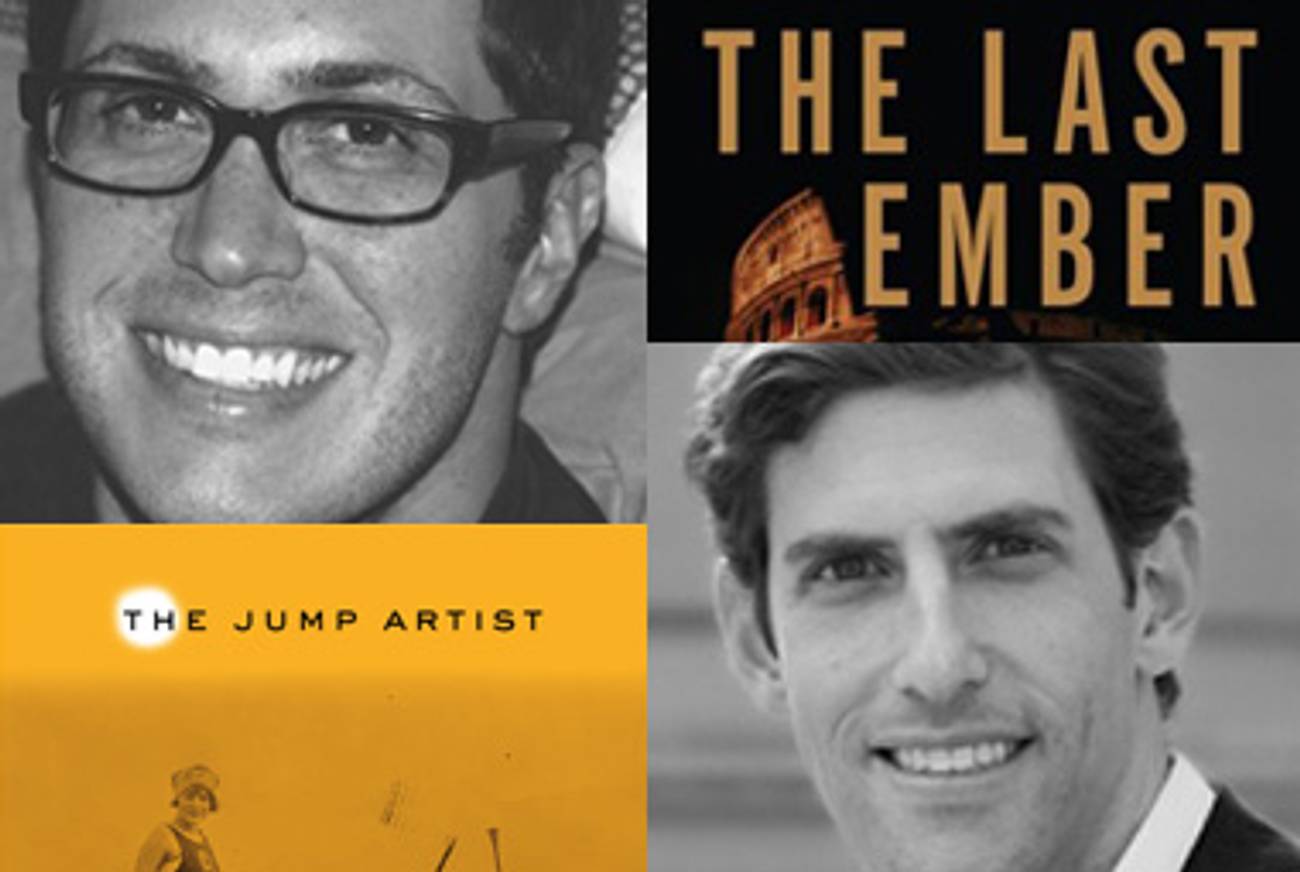Converts
Daniel Levin and Austin Ratner could have been professionals; instead they became novelists




Daniel Levin and Austin Ratner are both Jews and both converts, but their conversions were not of the religious sort. Each man recently published his first novel: Levin’s The Last Ember, a religiously-tinged thriller, debuted earlier this month, while Ratner’s The Jump Artist, a heady work about the real-life photographer Philippe Halsman, came out in May. Yet only a few years ago, Levin was fresh out of Harvard Law School and working at a top New York firm; Ratner, barely a decade ago, graduated from Johns Hopkins Medical School with plans to be a general practitioner. The two men, that is to say, both had perfectly respectable—some might say even more respectable—career paths open to them, and still they chose writing. As with a religious conversion, it bespeaks an especially powerful commitment to their adopted occupation.
Levin, a Fort Lauderdale native, is dashing in appearance and smooth and careful in speech. Though The Last Ember is remarkably erudite for a thriller—the title comes from Virgil’s Aeneid—it is ultimately loyal to its genre, with short, breathless chapters, dialogue-heavy prose, and a constantly energetic plot, all of which keep the reader constantly wondering what he’ll learn if he turns just one more page.
By contrast, the Cleveland-bred Ratner—more obviously bookish than Levin, with cropped hair, black-framed glasses, and slight shyness—has written a self-consciously literary novel. Unlike The Last Ember, The Jump Artist is obsessed with interiority rather than plot, and written with plenty of elegant embellishment. Of the two books, it probably merits the more serious appreciation. But it is not the one to take to the beach.
The Last Ember is a Jewish Da Vinci Code. (Levin notes that he had the idea for his book before Dan Brown’s blockbuster broke.) It tracks a lawyer-cum-classicist and an antiquities expert—who are also exes—as they rapidly make their way through Rome and Jerusalem trying to uncover the fate of a long-lost menorah from the ancient Temple. They are racing against the Waqf Authority, a mysterious Islamic land trust dating back to Saladin which retains sovereignty over the ground beneath the Temple Mount and which is conducting illegal excavations that threaten to erase the truth forever. Cue the string section: allegretto and forte, please.
The most sensational detail—the Waqf Authority—is real. Levin learned about it while clerking at Israel’s Supreme Court—a body that numerous times has found the Authority to have violated antiquities law. The authority clearly stirs Levin: “What you have operating today, sadly, whether it’s the Taliban blowing up buddhas in ’98 or the Waqf Authority excavating the Temple Mount, is groups of people trying to rewrite history,” he said. (The novel’s implied right-wing politics earned Levin a slot on G. Gordon Liddy’s radio show, but I got the firm sense that Levin is driven less by a specific agenda than by a classicist’s impulse to preserve the past rather than destroy it.)
But Levin is also refreshingly un-Dan Brown-like in reminding you that his theories are just theories—crafted to be coherent and perhaps even plausible but primarily for fun and, for now, fictional. His book, he says, is “a novel grounded in fact that strives to entertain as much as it teaches.” The balancing act works, and it’s no wonder that alongside the encomiums from best-selling thriller writers Matthew Pearl and Steve Berry is a blurb from Elie Wiesel: “a much-needed literary protest against modern and ancient historical revionism.”
To give away more than the barest bones of Levin’s plot would be a betrayal. But to find out what happens in Ratner’s The Jump Artist, more or less, you could hop over to Philippe Halsman’s Wikipedia page. In a nutshell: before Halsman became one of the most important and celebrated popular photographers of the post-World War II American moment, he was known as the Austrian Dreyfus, a young Latvian Jew falsely accused and convicted of killing his father while hiking in the Alps in the years immediately before Hitler rose to power. The book follows Halsman from that incident, spending extensive time on his trial and time in prison (during which he tries to kill himself—in many ways the novel’s dramatic heart), and finally to his release and rise as a photographer, first in Paris and then in the United States.
Though Ratner did conduct some original research, the book’s revelations are firmly novelistic: it realistically conveys the confusion and even guilt associated with false accusation, the desperation of attempting suicide, and the ambivalence of a redemption that gives you something so precious as your freedom but withholds something so intrinsic as your father.
In other words, Ratner’s touchstones aren’t classic biographies; they’re Ulysses and Kafka. “It seemed to me that a trial where someone is falsely accused is a symbolic apparatus for looking at a false guilt that’s maybe more universal,” Ratner said. “Something idiosyncratic happened to Philippe Halsman, but this was a way of dramatizing and exploring guilt, an internal state that maybe everybody feels, especially in the context of something traumatic happening, or a death, or grief.”
I wish I could reveal something undeniably lawyer-like about The Last Ember, or some aspect of The Jump Artist that makes it a novel only a doctor could write. But the neat parallels just aren’t there. Sure, Levin’s protagonist is, like him, a lawyer with training in the classics, but this is a trivial superficiality compared to The Last Ember’s sense of utter excitement and its lasting point about historical revisionism. And there is even less in The Jump Artist to suggest that its creator graduated from one of the country’s top medical schools. In fact, despite having once written a textbook chapter on physiology, Ratner has given us one of the most abstracted sex scenes I have ever come across in literature. (“I was more interested in the psychological aspects of his sexual encounters,” Ratner explained. “Anyway, there’s a limited range of things you can do, and it’s kind of a stereotyped human activity.”)
What I can reveal is that the two books undeniably reflect their authors’ deepest commitments—preoccupations they nurtured even before they became writers. When Levin was just out of law school and working at a big firm, he always volunteered for the antiquities cases. “We have a joke in classics that the worst thing you can say about an emperor is that nothing bad was said about him at all,” Levin explains. “It means that he had such tight control over the history books.” His passion for the importance of historical truth is obvious and unimpeachable.
To talk to Ratner, meanwhile, is to find a driving motivation that uncannily mixes the highly abstract and the deeply personal. On the one hand, he is as earnest a novelist of ideas as exists today, one whose current project is, he said, a collection of “anti-Borges stories.” (He finds the Argentinian writer Jorge Luis Borges’s little Kafkaesque parables to be “stale.”) But more than ideas compelled him to write a novel about a man dealing with false guilt at the death of his father: Ratner’s own father—a doctor, naturally—died when he was very young.
The two men’s other resonance is that both found appropriate vehicles for saying what they needed to say in things related to their Jewishness. This aspect shouldn’t be oversold: neither gives the impression that they absolutely had to write novels that extensively deal with their background. Best to say that each man saw in his heritage obvious and potent conduits for points he had independently wished to make. Much like being a lawyer or a doctor, being Jewish is a crucial part of each man’s identity that is nonetheless subservient to what is, in several senses of the term, each man’s prime occupation, pursued with the zeal of the converted: being a writer.
Marc Tracy is a staff writer at The New Republic, and was previously a staff writer at Tablet. He tweets @marcatracy.
Marc Tracy is a staff writer at The New Republic, and was previously a staff writer at Tablet. He tweets @marcatracy.